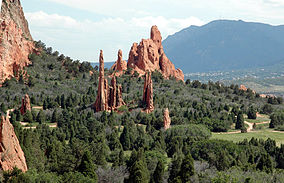Garden of the Gods
- For the Garden of the Gods in Southern Illinois, see Garden of the Gods Wilderness. For Hawaii, see Lanai.
| Garden of the Gods | |
|---|---|
 Garden of the Gods, Colorado Springs, Colorado | |
| Location | El Paso county in Colorado, USA |
| Nearest city | Colorado Springs, Colorado |
| Area | 3,300 acres (1,300 ha) |
| Established | 1909 |
| Governing body | Colorado Springs, Colorado |
Garden of the Gods is a public park located in Colorado Springs, Colorado, USA.
Genesis of the park
Entrance to the park is free according to the wish of Charles Elliott Perkins, whose children donated the land to the city of Colorado Springs in 1909.
Recreational opportunities
It contains numerous trails for hiking, walking, mountain biking and horseback riding. One of the most popular trails, named Perkins, has been paved in an effort to combat the erosion of the park's central garden caused by its numerous visitors. Visitors receive frequent reminders to watch out for rattlesnakes in the hot days of summer.
Because of the unusual and steep rock formations in the park, it is an attractive goal for rock climbers. Rock climbing is permitted, with annual permit obtained at the Garden of the Gods Visitor and Nature Center. The only requirements are reading the rules, proper equipment, climbing with a "buddy", and staying on established climbing routes. Due to the often unstable conditions of the sandstone—particularly after much precipitation—several fatalities have occurred over the years. This is a very popular bicycle-riding area because of the scenic views, safe one-way recently-paved roads, and healthy clean air.
Geological formations

The outstanding geologic features of the park are the ancient sedimentary beds of red and white sandstones, conglomerates and limestone that were deposited horizontally, but have now been tilted vertically and faulted by the immense mountain building forces caused by the uplift of the Pikes Peak massif. Evidence of past ages; ancient seas, eroded remains of ancestral mountain ranges, alluvial fans, sandy beaches and great sand dune fields can be read in the rocks. A spectacular shear fault can be observed where the Tower of Babel (Lyons Sandstone) contacts the Fountain Formation.[1] The name Colorado is said to come from the color of the sandstone. There are many fossils to be seen: marine forms, plant fossils, and some dinosaur fossils.
The hogbacks, so named because they resemble the backs and spines of a pig, are ridges of sandstone whose layers are tilted. Instead of lying horizontally, some layers are even vertically oriented. Each hogback can range up to several hundred feet long, and the tallest (called North Gateway Rock) rises to a height of 320 feet (98 m) tall[2]. A notable rock feature on this hogback, the Kissing Camels, appears to be two very large camels sitting face to face with their lips touching. The hump on the northern-most camel broke off from erosion and heavy climbing.
Garden of the Gods Visitor and Nature Center

The Garden of the Gods Visitor and Nature Center is located near the park entrance and offers free nature presentations daily. Natural history exhibits include minerals, geology, plants and local wildlife, as well as Native American culture. Programs include nature hikes, a Junior Ranger program, narrated bus tours, movies and special programs. Proceeds from the center support the Garden of the Gods Park. The center provides useful information for the experienced hiker as well as the armchair tourist.
Rock Ledge Ranch Historic Site
Near the entrance to the park is the Rock Ledge Ranch Historic Site, a recreation of rustic ranch of the late 1800s. The walking tour features a restored ranch house, demonstrations of smithing and facts about Native American activity in the area, including a small recreation of a Native American campsite. Rock Ledge Ranch is not part of the park, and it charges an admission fee.
The name
The name of the park dates back to August 1859 when two surveyors helping to set up nearby Colorado City were exploring the nearby areas. Upon discovering the site, one of the surveyors, M. S. Beach, suggested that it would be a "capital place for a beer garden." His companion, the young Rufus Cable, awestruck by the impressive rock formations, exclaimed, "Beer Garden! Why it is a fit place for the gods to assemble. We will call it the Garden of the Gods." The beer garden never materialized, but the name stuck.[3]
In 2006 a dinosaur species discovered there, was named after the park: Theiophytalia kerri.
Photos
-
The entrance to Garden of the Gods with Pikes Peak in the background
-
A view of Cathedral Valley showing some of its unusual hogback formations
-
Steamboat Rock in the late 1950's
-
Balanced Rock presents a popular photo opportunity[4]
References
This article needs additional citations for verification. (October 2007) |
External links
- Official Garden of the Gods website
- Rock Ledge Ranch Historic Site - official site
- Rock Ledge Ranch Historic Site - Colorado Springs information
- Virtual Tour - Roundus




![Balanced Rock presents a popular photo opportunity[4]](http://upload.wikimedia.org/wikipedia/commons/thumb/2/2f/Balanced_Rock.jpg/267px-Balanced_Rock.jpg)